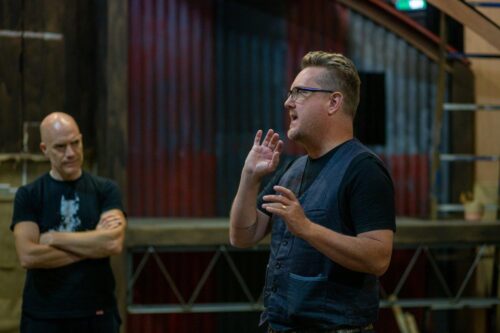Q&A with Andy Packer, Director of The Boy Who Talked To Dogs
Slingsby and State Theatre Company South Australia, in association with Adelaide Festival, present The Boy Who Talked to Dogs, which premieres 25 February – 14 March 2021. Based on the epic true story of Australia’s ‘Dog Man’ Martin McKenna and adapted for the stage by Amy Conroy, this production will bring together shadow-play and swinging Irish music to tell the story of one boy’s struggle for redemption and belonging. We spoke to Director Andy Packer about what to expect from this exciting new work.

Can you describe the development process for this work?
I first heard Martin McKenna on an episode of ABC Radio’s Conversations with Sarah Kanowski, in 2016. After hearing his incredible life story, I bought a copy of his memoir and we contacted his publisher to explore securing the rights to adapt his story to the stage.
With Martin’s story spanning Ireland and Australia, I thought it could be a great partnership between Slingsby and our friends and partners at Draíocht Arts Centre, Blanchardstown, Ireland.
I first met Draíocht’s Director, Emer McGowan, in 2006 at the Danish Children’s Theatre Festival in the city of Nykøbing Falster, and over the past 14 years we have become close colleagues. Once I had shared the ABC Radio interview with Emer, she was hooked. We set about building a team of leading Australian and Irish artists to create a work that was intercultural, allowing us to capture the nuance of Martin’s Irish childhood alongside his new life in Australia.
What drew you to this particular story?
Martin’s story is epic. The way he describes Limerick, Ireland, in the 60s and 70s really invites you into that world. Slingsby is drawn to telling stories about personal struggle, the individual climbing a mountain, finding a way out of the darkness, back to light and hope. These getting-of-wisdom, transformation or coming-of-age stories have power and resonance for our intergenerational audience.
I was really drawn to Martin’s ability tell his story, where so many things were against him, yet he apportions blame to himself as well as those around him. This honesty and taking responsibility are incredibly admirable and inspiring.
I was also very drawn to the role that dogs played in Martin’s life. Companion animals have increasing status around the world and I wanted to explore what this meant for Martin. I think a lot of people will be able to identify with the feeling that an animal – particularly a domesticated dog or cat – can understand us, have patience for us, when other humans (even ourselves) do not.
What makes this play and production unique?
This production is an extension of Slingsby’s exploration of immersive theatre. We love to put the audience into the world of the story. There is no dividing line between the audience and the performers. Both inhabit the same space, the same time, the same reality. This is something that no other artform can achieve.
When audiences come to see The Boy Who Talked to Dogs they really will become the community surrounding Martin when he was growing up. The story will take place in front of, around and amongst the audience. The proximity of the audience to the action may be akin to what is experienced in a small tent show at the Adelaide Fringe, but with the design and production values of a major work in a space that has been created especially for this story.
It is thrilling for an audience to be up close to virtuosic performers. The cast we have assembled for the show are outstanding and we are very excited to connect Adelaide Festival audiences with them.
How are shadow-play and music integrated into the play?
At Slingsby, we aim to create a ‘total theatre’, employing many elements of all of the performing art forms alongside a very strong visual arts influence.
We are very interested in light, shadow and how the contrast of the two can echo the shadows that were perhaps thrown onto cave walls millennia ago, when people gathered around a fire to share in tales of the day. Shadow-play is often an element in our productions and we are thrilled with the way playwright Amy Conroy has written the idea of shadows in Martin’s life into the script.
Likewise, music is always central to our theatre. All of our shows have included moments of song and through-scoring. We are blessed to have collaborated with composer Quincy Grant on all of our productions. His work for Slingsby has crossed the entire gamut and is a key ingredient in the emotional impact of the work.
As we started to put the creative team together for this show, I had dreamt of bringing Lisa O’Neill into the team. Lisa is a force in folk music and her non-sentimental, powerful lyrics seem the right fit for bringing Martin’s story to the stage. These songs will punctuate the story, a little like an aria in opera. The songs will create space for the audience to swim around in the emotional state of the character and the situation, before spoken text takes over and the story advances.
What is your vision for The Boy Who Talked to Dogs?
I hope we create a welcoming and exciting theatrical space for the audience to gather in to experience Martin’s story. I hope, at the end of the show, audiences feel that they have been on a great journey together and feel more empathetic towards the predicaments faced by other humans and themselves. I hope the show helps people to love theatre even more.
The Boy Who Talked To Dogs premieres 25 February – 14 March 2021 at the Thomas Edmonds Opera Studio, Adelaide Showgrounds.